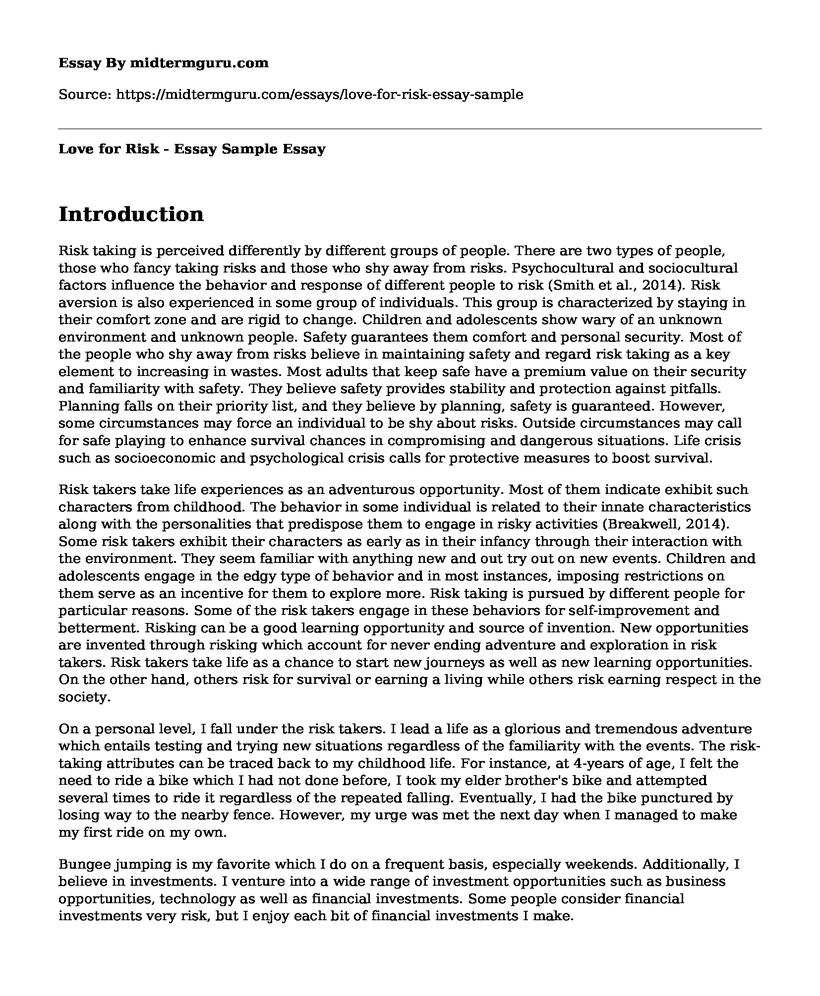Introduction
Risk taking is perceived differently by different groups of people. There are two types of people, those who fancy taking risks and those who shy away from risks. Psychocultural and sociocultural factors influence the behavior and response of different people to risk (Smith et al., 2014). Risk aversion is also experienced in some group of individuals. This group is characterized by staying in their comfort zone and are rigid to change. Children and adolescents show wary of an unknown environment and unknown people. Safety guarantees them comfort and personal security. Most of the people who shy away from risks believe in maintaining safety and regard risk taking as a key element to increasing in wastes. Most adults that keep safe have a premium value on their security and familiarity with safety. They believe safety provides stability and protection against pitfalls. Planning falls on their priority list, and they believe by planning, safety is guaranteed. However, some circumstances may force an individual to be shy about risks. Outside circumstances may call for safe playing to enhance survival chances in compromising and dangerous situations. Life crisis such as socioeconomic and psychological crisis calls for protective measures to boost survival.
Risk takers take life experiences as an adventurous opportunity. Most of them indicate exhibit such characters from childhood. The behavior in some individual is related to their innate characteristics along with the personalities that predispose them to engage in risky activities (Breakwell, 2014). Some risk takers exhibit their characters as early as in their infancy through their interaction with the environment. They seem familiar with anything new and out try out on new events. Children and adolescents engage in the edgy type of behavior and in most instances, imposing restrictions on them serve as an incentive for them to explore more. Risk taking is pursued by different people for particular reasons. Some of the risk takers engage in these behaviors for self-improvement and betterment. Risking can be a good learning opportunity and source of invention. New opportunities are invented through risking which account for never ending adventure and exploration in risk takers. Risk takers take life as a chance to start new journeys as well as new learning opportunities. On the other hand, others risk for survival or earning a living while others risk earning respect in the society.
On a personal level, I fall under the risk takers. I lead a life as a glorious and tremendous adventure which entails testing and trying new situations regardless of the familiarity with the events. The risk-taking attributes can be traced back to my childhood life. For instance, at 4-years of age, I felt the need to ride a bike which I had not done before, I took my elder brother's bike and attempted several times to ride it regardless of the repeated falling. Eventually, I had the bike punctured by losing way to the nearby fence. However, my urge was met the next day when I managed to make my first ride on my own.
Bungee jumping is my favorite which I do on a frequent basis, especially weekends. Additionally, I believe in investments. I venture into a wide range of investment opportunities such as business opportunities, technology as well as financial investments. Some people consider financial investments very risk, but I enjoy each bit of financial investments I make.
Conclusion
I believe I am a self-starter and, in most cases, I get it hard to second other people's ideas when I can take part in the invention and creation of new paths. Life entails both positive and negative perspectives. However, the negative part, which is vastly shied from, provides a better learning and growth opportunity. Targeting the negative dimension of life in attaining the new results stands as a driving force. Personally, life is a game which one has to lose or win. Losing requires the ability to risk or else the opportunity to win will never present itself. My love for change accounts for resentment of familiarity, sameness, and safety. These factors mark a psychological death to me and therefore, confining to safety and familiarity will impact on the lack of exploration and adventure.
References
Breakwell, G. M. (2014). The psychology of risk. Cambridge University Press.
Smith, A. R., Chein, J., & Steinberg, L. (2014). Peers increase adolescent risk taking even when the probabilities of negative outcomes are known. Developmental psychology, 50(5), 1564.
Cite this page
Love for Risk - Essay Sample. (2022, Oct 03). Retrieved from https://midtermguru.com/essays/love-for-risk-essay-sample
If you are the original author of this essay and no longer wish to have it published on the midtermguru.com website, please click below to request its removal:
- Essay on Cultural Aspects of Time and Ageing
- Paper Example on Gender Differences in Statistical Anxiety Among South Australian Undergraduate Students
- Blunt Abdominal Trauma in Children: The Case Study
- Traumatic Events & PTSD: Why Some Develop It & Some Don't - Research Paper
- Buchanan Unites Conservatives on Moral Issues in Bush Speech - Essay Sample
- Man With Rare Medical Condition Goes on Attack, Claiming Government Experimentation - Essay Sample
- Trauma: A Distressing Mental Health Phenomenon - Essay Sample







